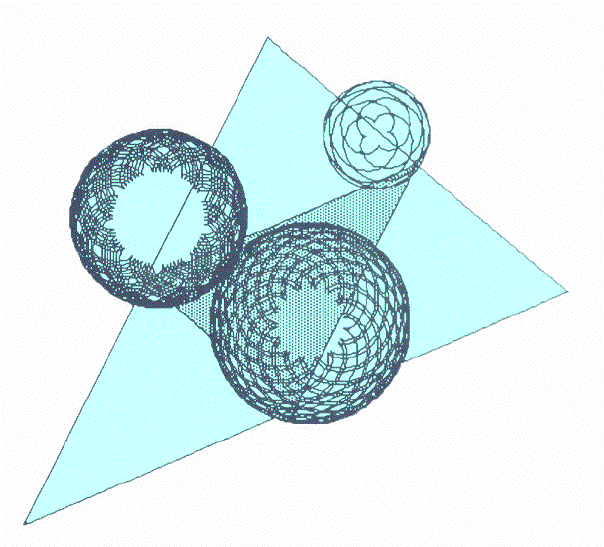 Terrell's GSP Sketch
Terrell's GSP SketchI met Terrell Campbell in the Spring of 1995 when he enrolled year in my Fundamentals of Algebra course as a sophomore at Dunwoody High School. Terrell had failed an entire year of mathematics (pre-algebra) the year before, scored in the first percentile on the math portion of the PSAT, was labeled remedial, and was placed in this course to be "brought up to speed so he could eventually pass Algebra One." Fundamentals of Algebra was a course being taught for the first time in Dekalb County. It was a course designed to allow students to study the concepts of algebra in a more hands on, investigative manner. From the first day, I noticed Terrell's aptitude in investigating mathematics. You could see the excitement in his eyes when he saw a pattern or solved a problem in a non-conventional manner. I believe that it was the first time, in a long time, that Terrell felt good about mathematics.
Terrell was very weak in basic arithmetic skills, but since that was not the focus of this class, Terrell finally did not have to focus on his weaknesses. As his confidence grew and his appreciation for what he was discovering developed, he became insistent upon improving his weak areas in mathematics. He worked with a fervor to learn to compute with integers and even created some of his own methods and rules to compute by. He was finally successful in overcoming what many people saw as his barrier in mathematics. Terrell found a way to use his creativity to empower himself.
As the year went on, Terrell continued to stand out in the area of creativity. He just had a way of asking questions or looking at a problem from another angle. His classmates looked to Terrell when they were "stuck" in a problem solving situation. While others could certainly "out compute" him, Terrell could usually find an avenue for exploration when everyone else had exhausted their own ideas. His communication skills were improving and his confidence increased almost daily. It was an exciting metamorphosis to be a part of.
During this spring quarter, Dunwoody High School was fortunate to have a computer lab installed. It was at this time that Terrell's class opted to study geometry in preparation for future math courses. I chose to have the geometry be discovery based using the Geometer's Sketch Pad (GSP) software. By constructing, measuring, conjecturing, and investigating, the students developed and proved their own theorems. Once again, Terrell proved to be outstanding in his ability to investigate and pose conjectures. The computer became his partner in exploration. He effectively used the technology as a tool to say: "What if?" or "Why?" or "Are you sure?".
One day, I showed the young man sitting next to Terrell how to use the animation feature of this package. It was just a brief demo, and I was unaware that Terrell was even listening or watching. Thirty minutes later, Terrell called me over to his computer and said "What do you think about this construction?" What I thought was "How did he learn to animate and what in the world has he constructed?" As Terrell explained to me what he had done, how the idea developed, and what he was investigating, I became fascinated with what he had discovered. His construction was both unique and creative. We both became enthralled with his questions about "Why is this happening?" and "What if I change this?". He was making predictions and testing them out. Each question led to another one.
I sent his ideas and investigations to the University of Georgia Department of Mathematics Education where they were discussed and then published in The Mathematics Educator (Volume 6 Number 1). His construction was the front cover of the publication
Terrell's GSP Sketch
and the article About the Cover read:
The design on the cover was created by Terrell Campbell, a sophomore at Dunwoody High School in Atlanta, GA...his teacher introduced her students to the computer program GSP and the concept of a medial triangle. From there, Campbell extended the problem to create designs similar to the one shown on the cover. He created the design by animating the vertices of a triangle around circles and tracing the locus of the midpoints of each side. Campbell is currently investigating the relationship of the radii of the circles to the designs created by the loci of the midpoints (p.2).
The young man who left my class in June of 1995 was forever changed by his experiences (and so was I). He held his head up a little higher, spoke a little louder, and felt a whole lot more confident. His mom noticed it, his classmates noticed it, I noticed it, his other teachers noticed it, and, most importantly Terrell noticed it.! Oh, and he did pass Algebra One the next year!